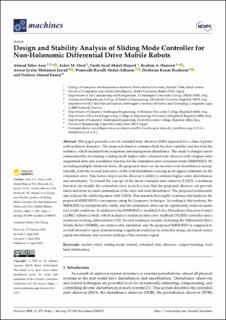| dc.contributor.author | Azar, Ahmad Taher | |
| dc.contributor.author | Abed, Azher M. | |
| dc.contributor.author | Abdul-Majeed, Farah Ayad | |
| dc.contributor.author | Hameed, Ibrahim A. | |
| dc.contributor.author | Jawad, Anwar Ja’afar Mohamad | |
| dc.contributor.author | Abdul-Adheem, Wameedh Riyadh | |
| dc.contributor.author | Ibraheem, Ibraheem Kasim | |
| dc.contributor.author | Kamal, Nashwa Ahmad | |
| dc.date.accessioned | 2023-10-27T12:28:58Z | |
| dc.date.available | 2023-10-27T12:28:58Z | |
| dc.date.created | 2023-05-22T12:58:04Z | |
| dc.date.issued | 2023 | |
| dc.identifier.citation | Machines. 2023, 11 (4), . | en_US |
| dc.identifier.uri | https://hdl.handle.net/11250/3099183 | |
| dc.description.abstract | This paper presents a novel extended state observer (ESO) approach for a class of plants with nonlinear dynamics. The proposed observer estimates both the state variables and the total disturbance, which includes both exogenous and endogenous disturbance. The study’s changes can be summarized by developing a sliding mode higher-order extended state observer with a higher-order augmented state and a nonlinear function for the estimation error correction terms (SMHOESO). By including multiple enhanced states, the proposed observer can monitor total disturbances asymptotically, with the second derivative of the total disturbance serving as an upper constraint on the estimation error. This feature improves the observer’s ability to estimate higher-order disturbances and uncertainty. To extend the concept of the linear extended state observer (LESO), a nonlinear function can modify the estimation error in such a way that the proposed observer can provide faster and more accurate estimations of the state and total disturbance. The proposed nonlinearity also reduces the chattering issue with LESOs. This research thoroughly examines and analyzes the proposed SMHOESO’s convergence using the Lyapunov technique. According to this analysis, the SMHOESO is asymptotically stable, and the estimation error can be significantly reduced under real-world conditions. In addition to the SMHOESO, a modified Active Disturbance Rejection Control (ADRC) scheme is built, which includes a nonlinear state error feedback (NLSEF) controller and a nonlinear tracking differentiator (TD). Several nonlinear models, including the Differential Drive Mobile Robot (DDMR), are numerically simulated, and the proposed SMHOESO is compared to several alternative types, demonstrating a significant reduction in controller energy, increased control signal smoothness, and accurate tracking of the reference signal. | en_US |
| dc.language.iso | eng | en_US |
| dc.publisher | MDPI | en_US |
| dc.rights | Navngivelse 4.0 Internasjonal | * |
| dc.rights.uri | http://creativecommons.org/licenses/by/4.0/deed.no | * |
| dc.title | Design and Stability Analysis of Sliding Mode Controller for Non-Holonomic Differential Drive Mobile Robots | en_US |
| dc.title.alternative | Design and Stability Analysis of Sliding Mode Controller for Non-Holonomic Differential Drive Mobile Robots | en_US |
| dc.type | Peer reviewed | en_US |
| dc.type | Journal article | en_US |
| dc.description.version | publishedVersion | en_US |
| dc.source.pagenumber | 0 | en_US |
| dc.source.volume | 11 | en_US |
| dc.source.journal | Machines | en_US |
| dc.source.issue | 4 | en_US |
| dc.identifier.doi | 10.3390/machines11040470 | |
| dc.identifier.cristin | 2148469 | |
| cristin.ispublished | true | |
| cristin.fulltext | original | |
| cristin.qualitycode | 1 | |

